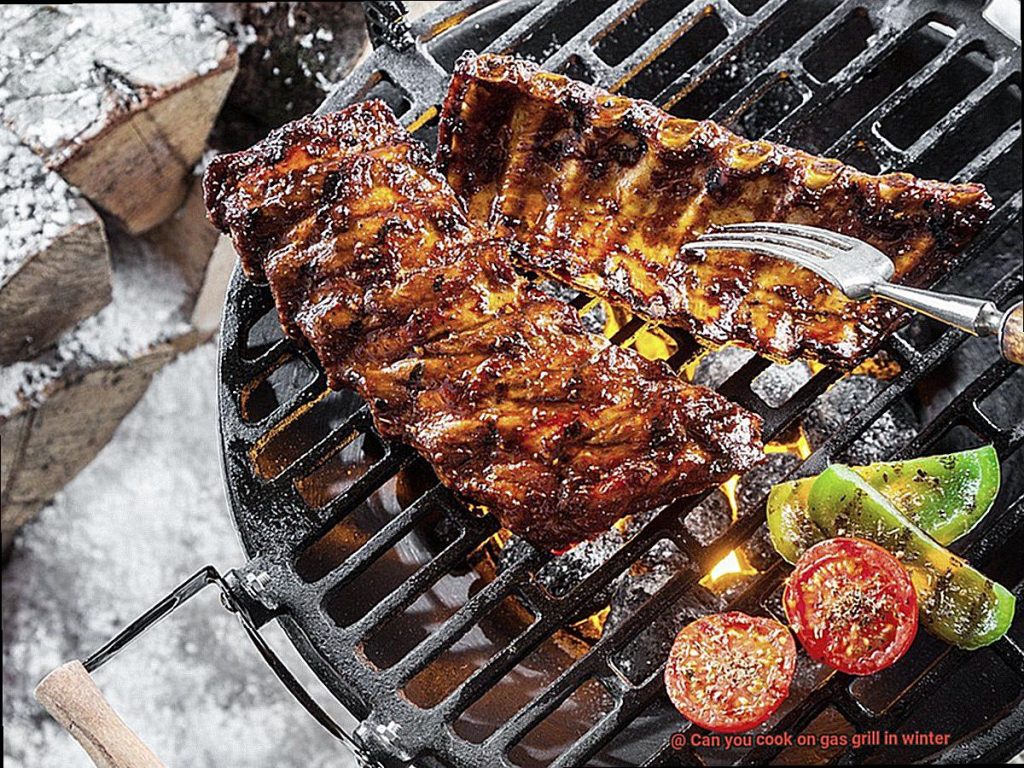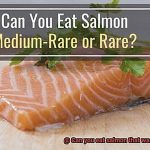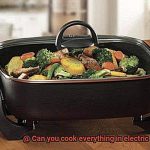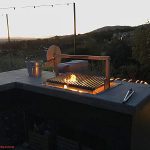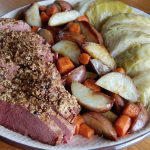Imagine this: a wintry evening, the air crisp and cold, but your taste buds are craving some succulent grilled chicken or perfectly seared ribeye. You might assume that your trusty gas grill is out of commission until spring arrives, but fear not. Cooking on a gas grill in winter can be done with a little preparation and know-how.
The first step is to ensure that your grill is in tip-top shape. Winter weather can wreak havoc on outdoor appliances, so give your grill a thorough cleaning and inspection before firing it up in the cold. Consider investing in a grill cover to shield it from snow and ice. Also, make sure you have enough propane or natural gas to power your grill since colder temperatures can cause quicker depletion of fuel.
However, even with a well-maintained grill and plenty of fuel, there are additional tips and tricks to keep in mind when cooking outdoors during winter weather. For instance, preheating your grill for a bit longer than usual can help compensate for the chilly outdoor temperatures. And if you’re concerned about the elements affecting your cook times, consider using a meat thermometer to guarantee that your food is cooked flawlessly.
So why let winter weather stop you from enjoying mouth-watering grilled meals year-round? With some extra preparation and attention to detail, cooking on a gas grill in winter can be an enjoyable experience that will satisfy all of your cravings.
Contents
Considerations for Winter Grilling
Grilling during winter can be an exciting experience, but it requires some additional preparation and careful consideration. Before revving up your gas grill, ensure that it is in excellent condition by checking its components such as burners, igniters, and fuel lines for any damage or wear and tear. Keep your grill covered when not in use to protect it from the harsh winter elements.
When grilling in colder temperatures, remember that gas grills typically require higher heat to cook food correctly. Thus, you may need to increase the heat a bit, which is why investing in a grill thermometer is a great idea to ensure that you are cooking your food at the right temperature. You may also want to consider using a windbreak or finding a sheltered area to grill as wind can cause fluctuations in temperature and make it harder to control the heat of your grill.
In addition to temperature, it’s crucial to choose the right foods for winter grilling. Heartier meats like beef and pork are great options as they can withstand longer cooking times and are less likely to dry out. Winter vegetables such as Brussels sprouts or squash are also excellent choices.
When cooking larger items like roasts or whole chickens, it’s essential to keep the lid closed as much as possible to maintain the temperature inside the grill and prevent heat loss due to cold air entering the cooking area. Preheating your grill for at least 10-15 minutes before cooking also helps ensure it reaches optimal cooking temperature.
Temperature Requirements
As winter approaches, it’s time to prepare for some delicious grilling. But as the temperature drops, it can be difficult to maintain a consistent heat level on your gas grill. The cold weather affects your grill’s performance, making it essential to understand the temperature requirements and how to keep your cooking temperature steady.
To ensure that your grilled dishes come out perfectly in the winter, here are some tips for maintaining consistent heat when cooking on a gas grill:
Firstly, preheat your grill for at least 10-15 minutes before cooking. Preheating ensures that the grates are hot enough for proper searing and that the temperature inside the grill is consistent. In extremely cold temperatures, preheating for longer than usual may be necessary to achieve the desired temperature.
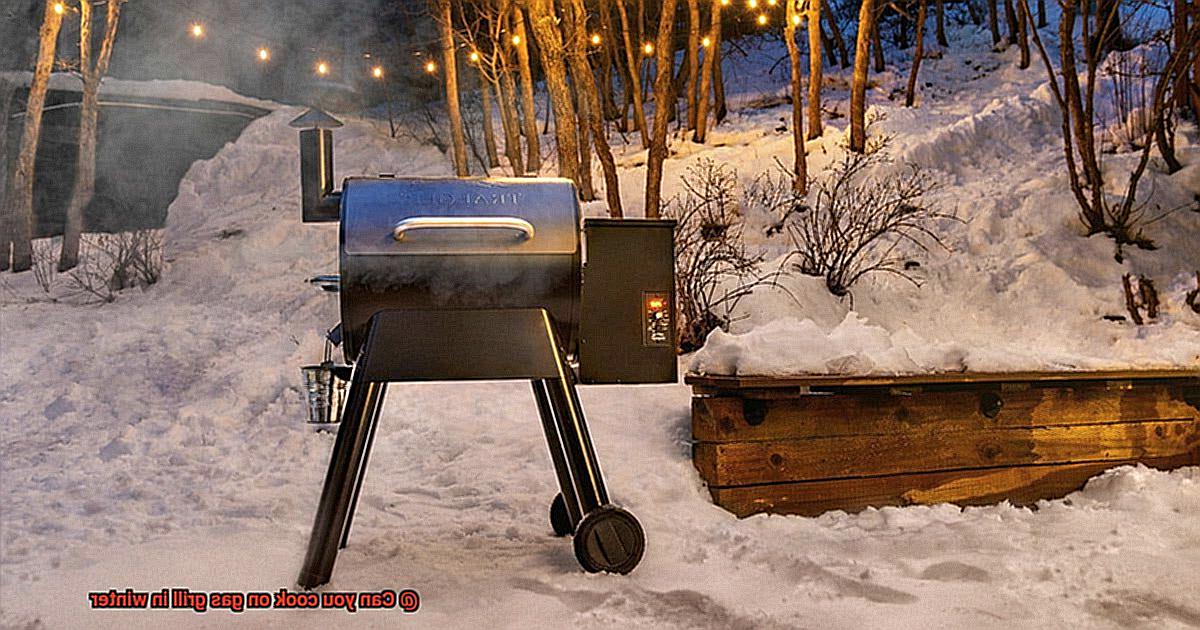
Wind can also affect the temperature of your grill. Therefore, find a sheltered area or use a windbreak around the grill to protect it from wind, which causes heat loss and makes it challenging to maintain a consistent cooking temperature.
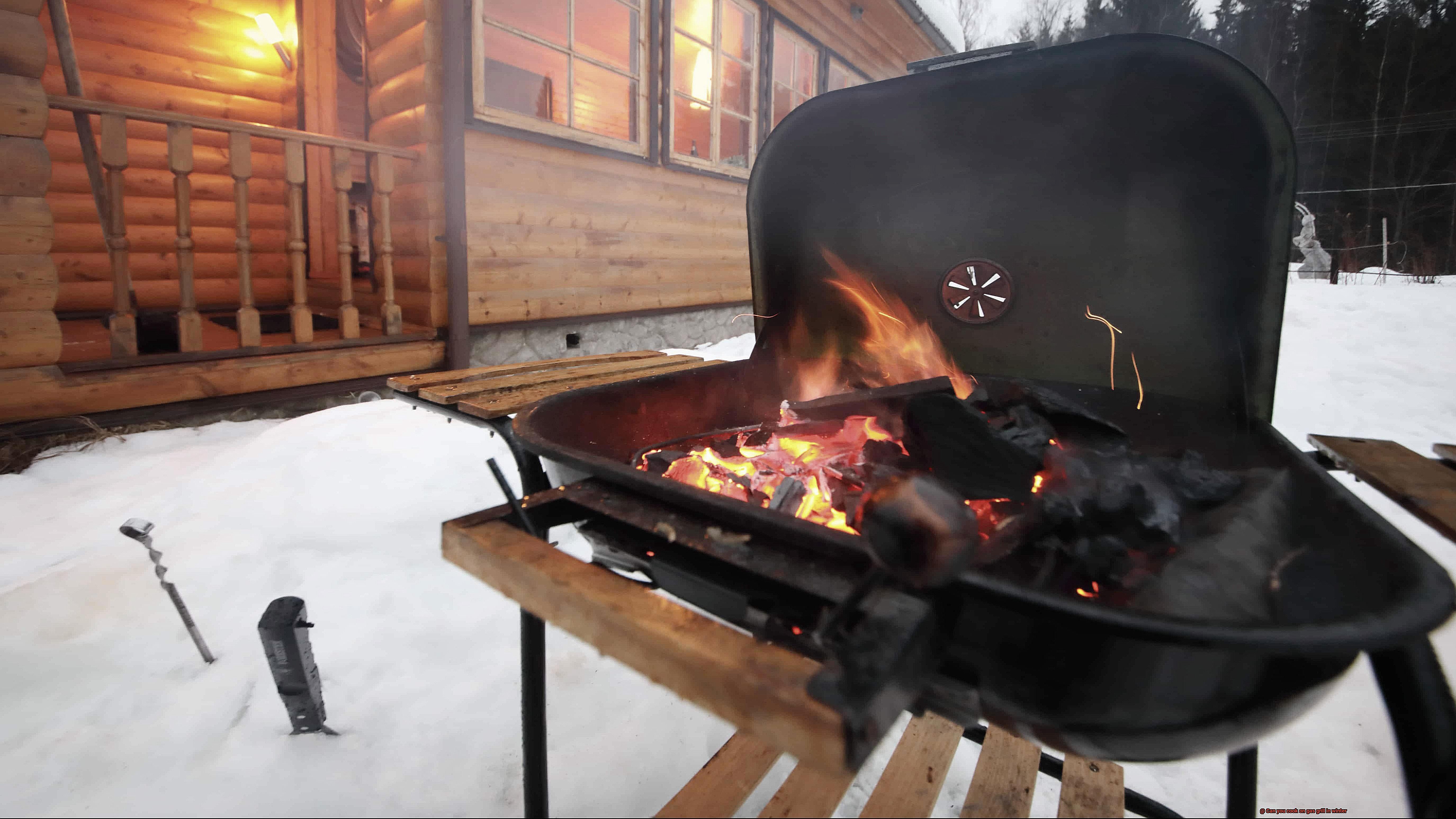
Keep an eye on the temperature gauge throughout the cooking process and adjust the heat as needed. It’s crucial to monitor the temperature gauge to prevent overcooking or undercooking your food.
Invest in a good quality meat thermometer, especially when grilling heartier meats and winter vegetables that require longer cooking times. This way, you can check the internal temperature of your food and ensure that it’s cooked to perfection.
Ideal Foods for Winter Grilling
Well, before you do, it’s important to choose the right foods that can withstand low temperatures and won’t dry out or become tough on the grill. As an expert on ideal foods for winter grilling, I’ve got you covered with some tasty options that are perfect for colder weather.
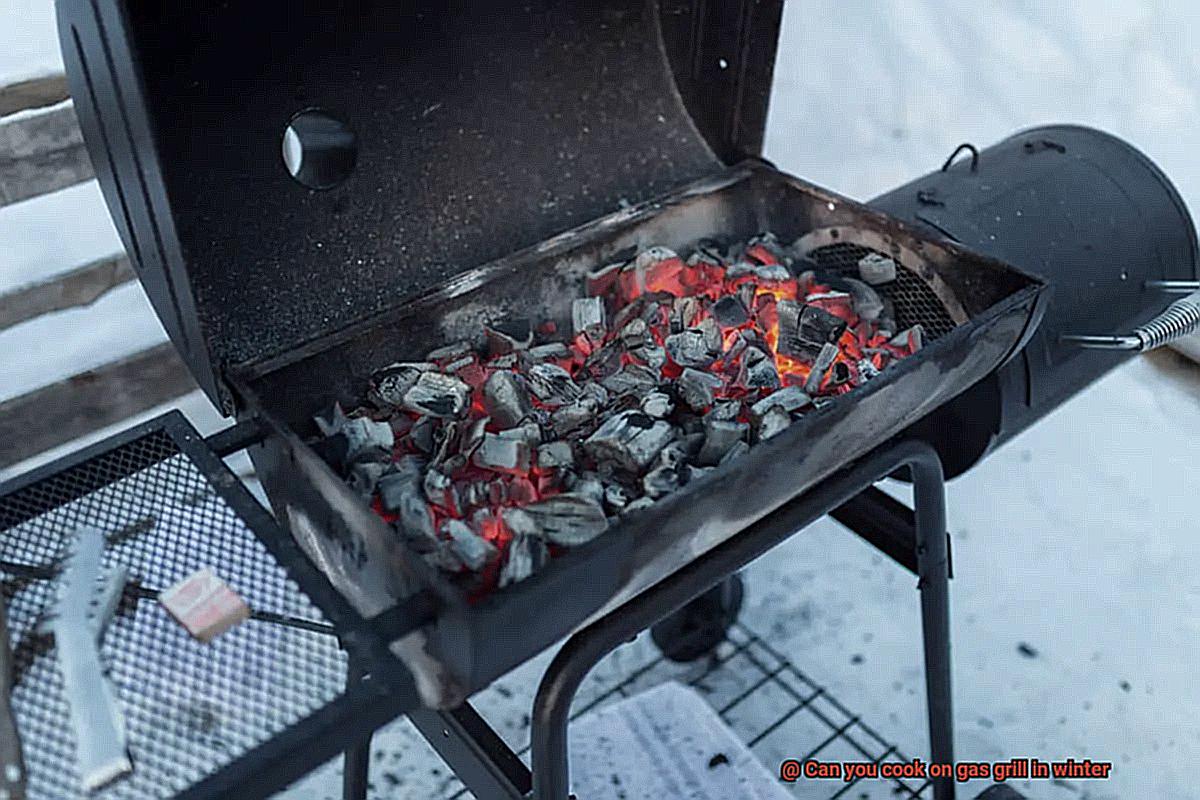
First up is steak. A thick and juicy cut is a classic option for winter grilling. It can handle the chilly temperatures and the high heat of the grill will give it a deliciously caramelized crust. The best part? You can enjoy it with a glass of red wine while watching the snow fall.
If beef isn’t your thing, pork chops are another great choice. They cook quickly and are full of flavor, making them a convenient option for busy weeknights. Plus, they can handle the cold weather without losing their tenderness or taste on the grill.
For those looking for a healthier twist, grilled root vegetables are perfect for winter. Heartier veggies like carrots, beets, and sweet potatoes can be grilled whole or sliced into rounds or wedges for a satisfying side dish. The smoky flavor from the grill will elevate their natural sweetness, making them a crowd-pleaser for any meal.
Chicken thighs are also ideal for winter grilling. They’re more forgiving than chicken breasts and won’t dry out as easily on the grill. Their rich flavor pairs perfectly with winter spices like cinnamon and nutmeg, making them a comforting option for chilly nights.
And let’s not forget about kabobs. They’re fun, easy to make, and perfect for grilling a variety of foods at once. Mix and match meats, veggies, and even fruits to create a colorful and flavorful meal that’s sure to impress your guests.
Keeping the Lid Closed
There’s nothing quite like the satisfaction of cooking up a delicious meal on the grill, even when the temperatures are frigid. But if you want to make sure your food cooks evenly and thoroughly, you need to keep the lid closed.
Why is this so important? Well, it all comes down to heat retention. When you’re grilling in the winter, the outside air is working against you. If you leave the lid open for too long, all that precious heat will escape into the chilly atmosphere. This will result in longer cooking times and unevenly cooked food.
To ensure that your grill stays hot enough to cook your food effectively, invest in a high-quality gas grill with a sturdy and secure lid. Look for models with a tight-fitting lid and a reliable seal around the edges. This will help prevent heat from escaping and guarantee that your food cooks evenly.
Another tip for keeping the lid closed is to resist the urge to check on your food too often. Although it’s tempting to peek inside and see how things are coming along, every time you lift the lid, heat escapes. Try to keep the lid down as much as possible and only open it when necessary.
But keeping the lid closed is just one part of successful winter grilling. Preheating your grill properly is also essential for ensuring that your food cooks evenly. To preheat your grill, turn it on and let it heat up for 10-15 minutes before adding your food.
And don’t be afraid to get creative with your winter grilling recipes. From juicy steaks to smoky root vegetables, almost anything can be cooked to perfection on the grill. Just remember to keep that lid closed and enjoy the delicious results of your efforts.
In summary, here are some tips for successful winter grilling:
Preheating Your Grill
Before you start sizzling up your favorite meals, remember that preheating your grill is a crucial step that should never be skipped – especially during the colder months. Here’s why:
In low temperatures, the metal parts of your gas grill can become brittle and crack if exposed to sudden changes in heat. To avoid this, preheat your grill slowly and gradually. Begin by turning on the burners to their lowest setting and let the grill warm up for at least 10-15 minutes before raising the temperature to your desired cooking level. This simple step will ensure that your food is cooked to perfection.
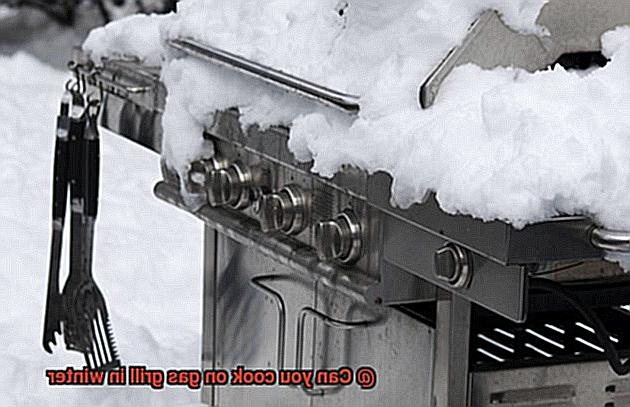
But that’s not all. The type of fuel you use can also impact how well-preheated your grill gets. Propane gas can be affected by cold weather and may not flow as efficiently as it does in warmer seasons. So, keep an eye on the flame and adjust the temperature accordingly to avoid any issues.
Another thing to note is that preheating your grill in winter may take longer than it does in summer. The colder air surrounding your grill means it will take more time for internal temperatures to rise. Don’t rush this process; give your grill ample time to heat up before placing any food on it.
To summarize, here are some key tips for preheating your gas grill during winter:
- Start slowly and gradually.
- Keep an eye on the flame and adjust temperature as needed.
- Be patient – colder air means slower heating times.
Using a Meat Thermometer
Then you need to have a meat thermometer in your grilling arsenal. Using a meat thermometer is not only essential but can also be a fun and exciting way to cook delicious and safe meals. As an expert in using a meat thermometer when grilling in the winter, I’m here to share some tips on how to use it properly.
First things first, when using a meat thermometer, make sure you insert it into the thickest part of the meat. Avoid touching any bones or fat as this can give you an inaccurate reading. Once inserted, wait for a few seconds for the thermometer to give you a reading. It’s that simple.
Now let’s talk about temperatures. Did you know that different types of meat require different internal temperatures to be cooked safely and deliciously? For instance, chicken should be cooked to an internal temperature of 165°F (75°C), while beef should be cooked to 145°F (63°C) for medium-rare and 160°F (71°C) for medium. To ensure that you’re cooking your meat to the appropriate temperature, check a reliable source for temperature guidelines.
It’s also crucial to clean your meat thermometer after each use to prevent cross-contamination. Washing the probe with hot, soapy water and wiping it dry with a clean towel will do the trick. This way, you can keep your thermometer in good condition and prevent any potential foodborne illnesses.
Adjusting Cooking Times Accordingly
If so, you know that cooking on a gas grill in winter can present a few challenges. But fear not. With a few adjustments to your cooking times, you can still achieve delicious and perfectly cooked meals on your gas grill all winter long.
One crucial factor to consider is the thickness of the food you’re grilling. Thicker cuts of meat, such as steaks or pork chops, will take longer to cook through in colder temperatures. To ensure that your meat is cooked thoroughly, it may be necessary to increase the cooking time by 5-10 minutes per side, depending on its thickness.
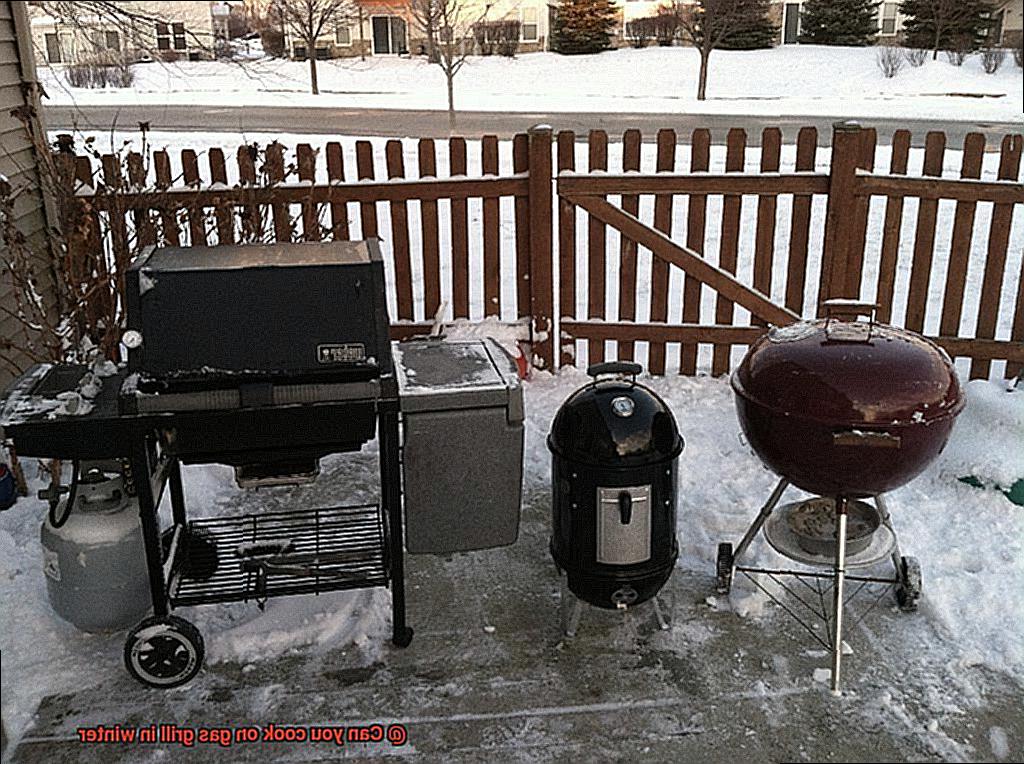
Similarly, vegetables may also take longer to cook in colder temperatures. Root vegetables like potatoes and carrots will take longer to soften, while lighter vegetables like zucchini and peppers may still cook quickly but require more attention. Be sure to keep an eye on them and give them a bit more time to cook through.
In addition to food thickness, it’s essential to monitor the temperature of your grill itself. In colder temperatures, the grill may take longer to heat up and maintain its temperature. To avoid this issue, preheat the grill for at least 10-15 minutes before cooking and use a thermometer to ensure that it’s maintaining a consistent temperature throughout the cooking process. This will help ensure that your food is cooked evenly and thoroughly.
Finally, don’t forget about wind. Wind can have a significant impact on cooking times, causing the temperature of the grill to fluctuate. To minimize this effect, try to position your grill in a sheltered area or use a windbreak if possible.
Tips and Tricks to Make Winter Grilling Easier
Grilling during the winter months can be a daunting task, but with the right tips and tricks, it can be an enjoyable experience. Here are some ways to make winter grilling easier:
Protect Your Grill
The harsh winter weather can cause damage to your grill, so it’s important to invest in a good quality grill cover. This will protect your grill from rust and other damage. Additionally, consider using a grill mat to prevent any potential damage to your deck or patio.
Stock Up on Fuel
In colder temperatures, propane tanks may need to be refilled more frequently, so make sure to stock up on enough fuel. It’s also a good idea to keep spare propane tanks on hand for emergencies.
Preheat Your Grill
When grilling in the winter, it’s important to preheat your grill for a longer period of time than usual. This will ensure that your food cooks evenly and thoroughly. You may also want to use a temperature probe to monitor the internal temperature of your food.
Use Foil Packets or Cast Iron Skillets
Foil packets or cast iron skillets are great options for winter grilling. They help hold in heat and prevent food from sticking to the grates. Try using wood chips or pellets to add extra flavor to your meals.
Brush Your Grill Grates
Snow and ice can accumulate on your grill grates, making them difficult to clean. Make sure to brush them off before cooking to prevent food from sticking.
LGLk6tqoZrg” >
Also Read: Can a Weber BBQ Grill Get Wet If left Outside in Rain?
Conclusion
In conclusion, don’t let winter weather stop you from enjoying the delicious taste of grilled food. With a little preparation and some expert tips, cooking on a gas grill in winter is entirely possible. First and foremost, ensure that your grill is in tip-top shape by giving it a thorough cleaning and inspection before firing it up in the cold. Additionally, make sure you have enough propane or natural gas to power your grill since colder temperatures can cause quicker depletion of fuel.
To maintain consistent heat when grilling during winter, preheating your grill for at least 10-15 minutes before cooking is crucial. Wind can also wreak havoc on the temperature of your grill, so finding a sheltered area or using a windbreak around the grill can help protect it from gusts and prevent fluctuations in temperature.
When choosing foods for winter grilling, opt for heartier meats like beef and pork that can withstand longer cooking times without drying out. Winter vegetables such as Brussels sprouts or squash are also excellent choices.
Using a meat thermometer when grilling in winter is another essential tip to ensure that your food cooks safely and deliciously. Adjusting cooking times accordingly for thicker cuts of meat or vegetables that may take longer to cook is also necessary.
So don’t let the cold weather keep you from indulging in succulent grilled chicken or perfectly seared ribeye – fire up that gas grill.

